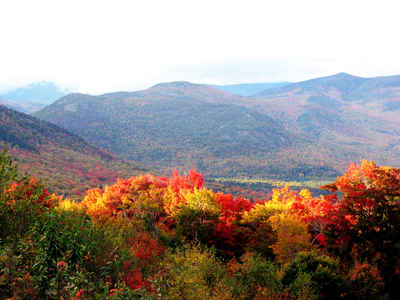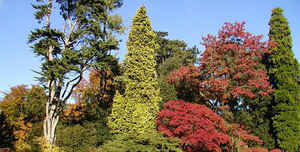New Hampshire State Tree
White Birch
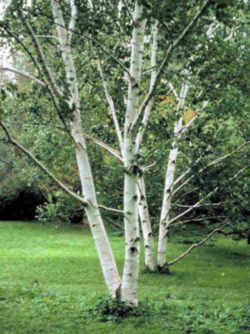
(Betulaceae Betula papyrifera)
Adopted in 1947.
The White birch, (Betulaceae Betula papyrifera,) was designated as New Hampshire's official state tree in the 1947 Legislature without argument or opposition. Also known as canoe birch or paper birch (native Americans used white birch bark to make canoes and it was also used for writing paper).
It was sponsored by Senator J. Guy Smart of Durham, on behalf of the New Hampshire Federation of Garden Clubs, of which Mrs. Helen C. Funkhauser of Durham was president. They easily piloted the birch tree bill through the Senate and the House of Representatives, and it was signed into law on May 22, 1947 by Governor Charles M. Dale of Portsmouth.
The official state tree was labeled "Queen Of The Woods," by Evelyn W. Cortez, in an article in the December, 1947, issue of New Hampshire Troubadour, the one-time esteemed state government booklet, which said in part:
There are several reasons for choosing the white birch for the state tree. Not only is it native to New Hampshire - a first consideration - but it is found in all regions of the state, growing as it does on rich-wooded slopes and along the borders of lakes and streams. It is a characteristic part of the scenery.
The beauty of the white birch is dramatic against the green of other trees. While all birches are sturdy and graceful and may grow tall, the canoe, or white birch sometimes reaches a height of 80 feet. Its bark is chalky to cream white, tinged with yellow, and peels in thin film-like layers. Its leaves are broadly oval on short, stout leaf stalks. The cylindrical fruit spikes usually droop in contrast to the more commonly erect fruit of the other birches.
New Hampshire Revised Statute Annotated (RSA) 3:6
Anderson, Leon. History. Manual for the General Court 1981.
New Hampshire State Tree: White Birch
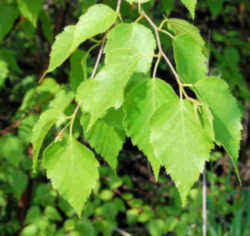
Typical paper birch (Betula papyrifera var. papyrifera), also called white birch, canoe birch, or silver birch, and the other five intergrading geographical varieties, western paper birch (B. papyrifera var. commutata (Regel) Fern.), mountain paper birch (B. papyrifera var. cordifolia (Regel) Fern.), Kenai birch (B. papyrifera var. kenaica (W. H. Evans) Henry), Alaska paper birch (B. papyrifera var. neoalaskana (Sarg.) Raup), and northwestern paper birch (B. papyrifera var. subcordata (Rydb.) Sarg.) are the most widely distributed birches in North America, mostly in Canada. These medium-sized, fast-growing trees develop best on well-drained, sandy loams on cool moist sites. They are commonly found in the mixed hardwood-conifer forests but may form nearly pure stands where they pioneer areas disturbed by fires or logging. Paper birch is short-lived and rarely lives more than 140 years. Commercially the lumber is used for veneer, pulpwood, and many specialty items. The handsome foliage and showy white bark make the trees attractive for landscaping. They are important browse plants for animals, and the seeds, buds, and bark are also eaten by wildlife.
Identification of the White Birch
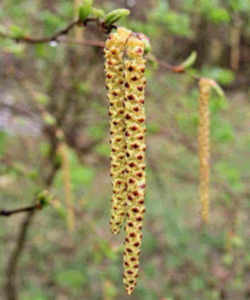
Betula papyrifera is a species of birch native to northern North America. It is the provincial tree of Saskatchewan and the state tree of New Hampshire
- Leaf: Alternate, simple, pinnately-veined, ovate in shape, with coarsely doubly serrate margins, an acute tip and rounded base.
- Flower: Preformed aments, male near the end of the twig in 2's or 3's, 3/4 to 1 1/4 inches long. Female flowers are upright, 1 to 1 1/4 inches long. Flowers April to June.
- Fruit: Cone like, cylindrical 1 to 1 1/2 inches long, deciduous at maturity, releasing elliptical 2-winged nutlets. Matures in the autumn, disperses over winter.
- Twig: Slender, dull red-brown, lacking wintergreen smell when cut. Terminal bud absent, lateral buds are gummy, chestnut brown in color. Spur shoots present on older growth.
- Bark: Smooth, thin, chalky-to-creamy white; peeling in horizontal papery strips. Brown to black and furrowed at base. Orange inner bark.
- Form: A medium-sized tree with a pyramidal or irregular crown.
New Hampshire Law
The law designating the white birch tree as the official New Hampshire state tree is found in the New Hampshire Statutes, Title 1, Chapter 3, Section 3:6.
TITLE I
THE STATE AND ITS GOVERNMENT
CHAPTER 3
STATE EMBLEMS, FLAG, ETC.
Section 3:6
3:6 State Tree. --The white birch tree, Betula papyrifera, is the state tree of New Hampshire.
Source. 1947, 158:1, eff. May 22, 1947.
Taxonomic Hierarchy: White Birch Tree
Kingdom: Plantae - Plants
Subkingdom: Tracheobionta - Vascular plants
Superdivision: Spermatophyta - Seed plants
Division: Magnoliophyta - Flowering plants
Class: Magnoliopsida - Dicotyledons
Subclass: Hamamelididae
Order: Fagales
Family: Betulaceae - Birch family
Genus: Betula L. - birch
Species: Betula papyrifera Marshall - paper birch





